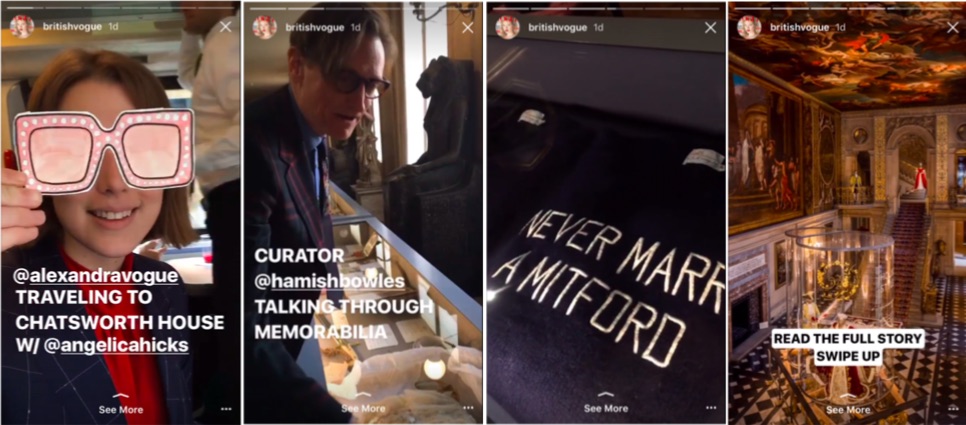Connect with execs from The New York Times, TIME, Dotdash Meredith and many more
How British Vogue used Instagram Stories to gain a million followers in one year
Fashion brand feeds on Instagram tend to be highly polished and painstakingly curated. But for British Vogue, the platform’s Stories feature allows the publisher to be a little more playful.
“We’re trying to do fun things, like filming in the fashion cupboard, out in a shoot, a mix of things tied to special occasions,” said Sam Rogers, acting editor at Vogue.co.uk.
It seems to be working. The fashion brand’s U.K. account has doubled to 2 million followers in the last year, thanks largely to how it has honed its Instagram Stories and video output since December. Tubular Labs data shows the Instagram account had nearly 850,000 video views over the month of February. Of course, fashion weeks across the globe make this a big month in the industry calendar. The previous months saw the account fetch around 400,000 video views. For Stories, the publisher said it gets around 80,000 views per clip, with Stories usually containing half a dozen clips.
When the Stories feature launched in August, Vogue tested it out on a daily basis. Output has since slowed down to a couple a week. In this time, the publisher has learned a few things. “We’re consciously trying not to make it an endless reel of finales and runways. That’s the tendency elsewhere,” said Rogers.
Alternatively, Vogue widens the aperture. The publisher pulls in talent for takeovers, for instance, American model Cara Taylor, published a back-stage diary for the feed. Stories is about giving access, as such it regularly follows a Vogue employee throughout their day.
Over the course of the year, British Vogue’s digital picture editor Alastair Nicol has hammered out a visual vocabulary for different types of Stories. Instagram Stories with an opinion — like how lacking the world will be without the Australian soap “Neighbours” — start with a strong, still image and graphics. Stories that are about beauty — like ones that highlight talent from the issue — are more fast-paced and pressing. Shopping Stories are more product focused.
For users, the default for Stories is mute, but some of Vogue’s — like a recent Story following editor-in-chief Alexandra Shulman to Chatsworth House for a fashion exhibition, where she talks about the objects on display — require sound. When it’s relevant, it uses the swipe-up feature to take viewers to an article. In this case, the swipe-up reveals an article on how five centuries of fashion were discovered at Chatsworth House, forming the basis of the exhibition. The Story suggests to the viewer by the fourth clip to swipe up and read more, and while it doesn’t have hard numbers, Rogers said this leads to traffic bumps.

Rather than dedicated teams, Instagram is a shared responsibility, everyone on the 10-strong digital team and the print team has access. There are overarching editorial plans — helping drive the endeavor forward is Emily Sheffield, deputy editor and associate digital director at the publisher — but there’s also the flexibility for everyone to contribute. For Stories, content is fed back to Nicol to keep the composition consistent.
Outside of Stories, Instagram is a traffic driver for British Vogue. “From talking to other brands, I think that’s quite unusual,” said Rogers. The link in its bio directs users to a landing page where it keeps editorial connected to its posts. It publishes between four and eight posts a day and has directed posts away from the product collage motifs to ones that aim to tell a story, like model Gisele Bündchen on a horse, for example, which links to the article “The fashion girls who’d rather be riding.” Around 80 percent of Instagram posts link to an article, Rogers estimates Instagram referrals account for less than 10 percent of the site’s total traffic. It doesn’t run ads in Instagram but publishes some branded content. The primary purpose is to build awareness and point readers to more in-depth pieces elsewhere.
While it’s done a couple of Instagram Live streams when they’ve been called for, it’s not something it’s regularly planning, “it feels rather forced,” said Rogers, adding that notifications when the brand is going Live are also a bit intrusive. “Stories feels much more subtle.”
Images: Courtesy of British Vogue via Instagram.
More in Media

Three publishers’ workforce diversity reports show DEI efforts remain sluggish
Overall, staff diversity at The New York Times, Hearst and Condé Nast has either marginally improved or stalled in 2024, according to their annual workforce diversity data this year.

Retail media meets publishing: News UK, Future and Ocado tap clean room tech for smarter data targeting
News UK, The Independent, Immediate Media and Future are teaming up with retail media network Ocado to test clean room-powered data matching.

From sidelines to spotlight: Esports events are putting creators center stage
Esports events’ embrace of content creators reflects advertisers’ changing priorities across both gaming and the wider culture. In the past, marketers viewed esports as one of the best ways to reach gamers. In 2025, brands are instead prioritizing creators in their outreach to audiences across demographics and interest areas, including gaming.








